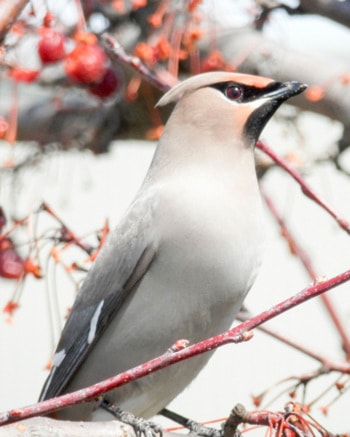A peregrine falcon is getting the spotlight in this year’s annual Christmas bird count, spotted in both Naramata and in downtown Penticton.
“Our counters in Naramata, Jim and Diedre Turnbull saw a peregrine falcon first thing in the morning, which is quite a rare bird in the count. We’ve only seen one a couple of times before,” said Dick Cannings, co-ordinator for the Canadian Christmas bird counts. The falcon was later spotted and photographed by another group in downtown Penticton.
Two other species, the European starling and the Bohemian waxwing, topped the list for sheer numbers, however.
“We had 11,000 starlings in that count, which is probably double what we normally get. A lot of those are on the Naramata Bench,” said Cannings.
Unlike the starlings, which were introduced to North America in the 19th century, the waxwing is a native species, which also travels in large flocks.
“They nest in the boreal forests of Western Canada. They are often one of the commonest birds on our count, we often get 2,000 to 3,000,” said Cannings. “This year we had over 7,000, which is the highest number we have ever had, and we have been doing this for over 50 years.”
On the down side, diving ducks seem to be disappearing from the area. Numbers of canvasbacks and redheads, two prized hunting duck species, have seen substantial drop in numbers.
“Redheads were declining through the 50s, 60s and 70s, but seemed to be coming back up,” said Cannings. “Our numbers seem to be going down. We used to have 3,000 redheads down here in the southern end of the lake every winter and this year we only had about 500 off Three Mile Beach.”
And canvasbacks have dropped to zero, where normally 50 to 100 were spotted.
“We have missed them in two of the last four years and only had two and three in the others,” said Cannings. “The other species that associate with them, the ring-necked duck, we have missed for the last three years in a row.”
The Christmas bird count was started as a social and sporting event, and still is to a large degree, though it has also grown into an important record of North American bird populations.
“It’s done in over 2,000 locations across North America, so that when people like me wonder what is happening to these ducks, I can look at the overall results and see if they are declining everywhere,” said Cannings.
It was started in 1900 by Frank Chapman, an ornithologist whom Cannings characterizes as “one of the grandfathers of the environmental movement.”
A century ago, the tradition was to go out on Christmas Day and do what was called a side hunt. Men would meet, break up into teams, and, in Chapman’s words, “hie them to the fields and woods on the cheerful mission of killing practically everything in fur or feathers that crossed their path — if they could.”
By 1900, the practice was dying out, and Chapman wanted to speed up the process, proposing counting birds on Christmas Day rather than killing them.
“I think there were 25 counts that year. And now there is over 2,000. It has been growing steadily, especially in the last 20 years,” said Cannings. “When I took over the co-ordination of Canadian counts, about 15 years ago, we had 250 counts and now we are at 450. It’s really gaining in popularity still.”
